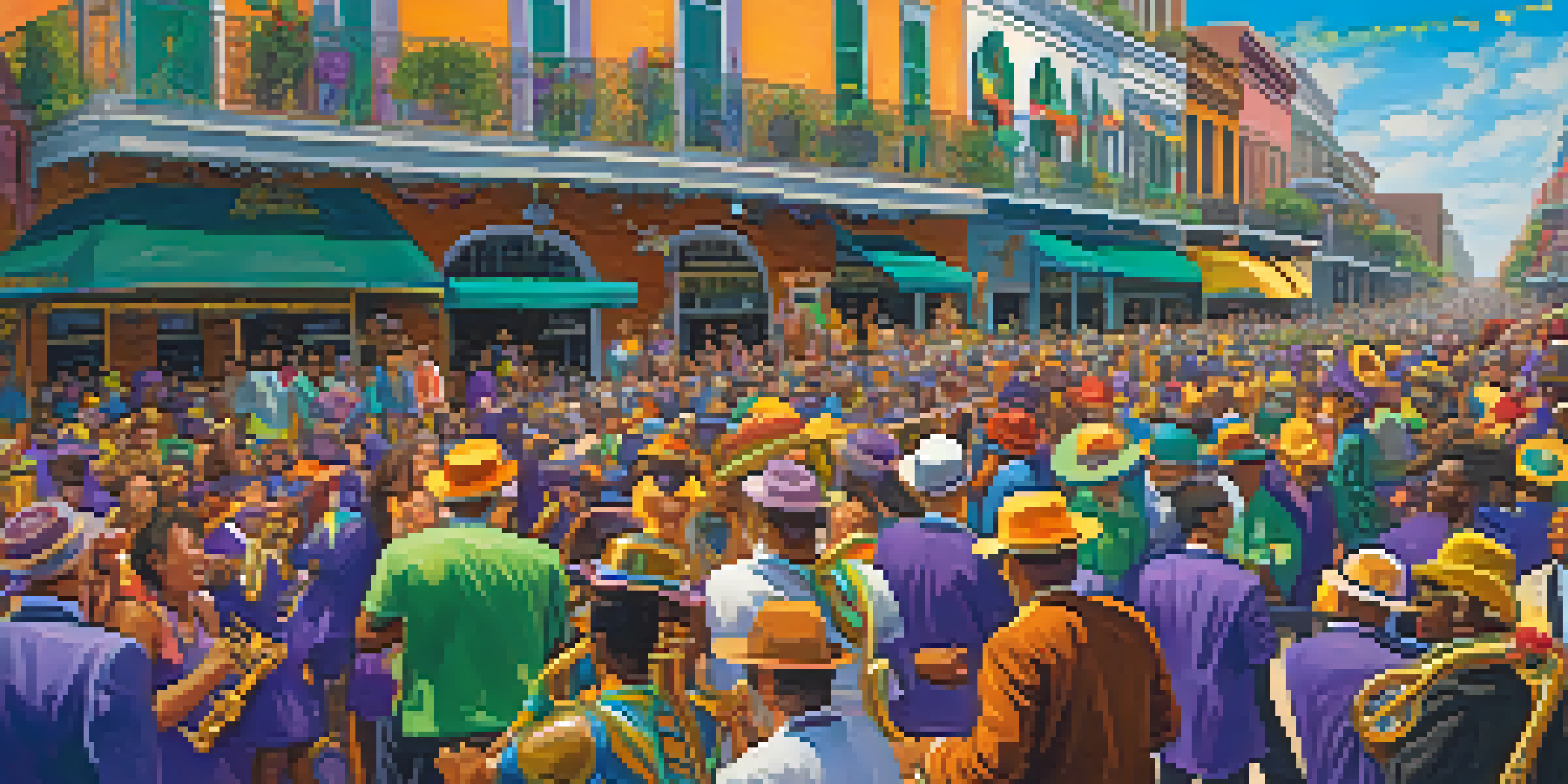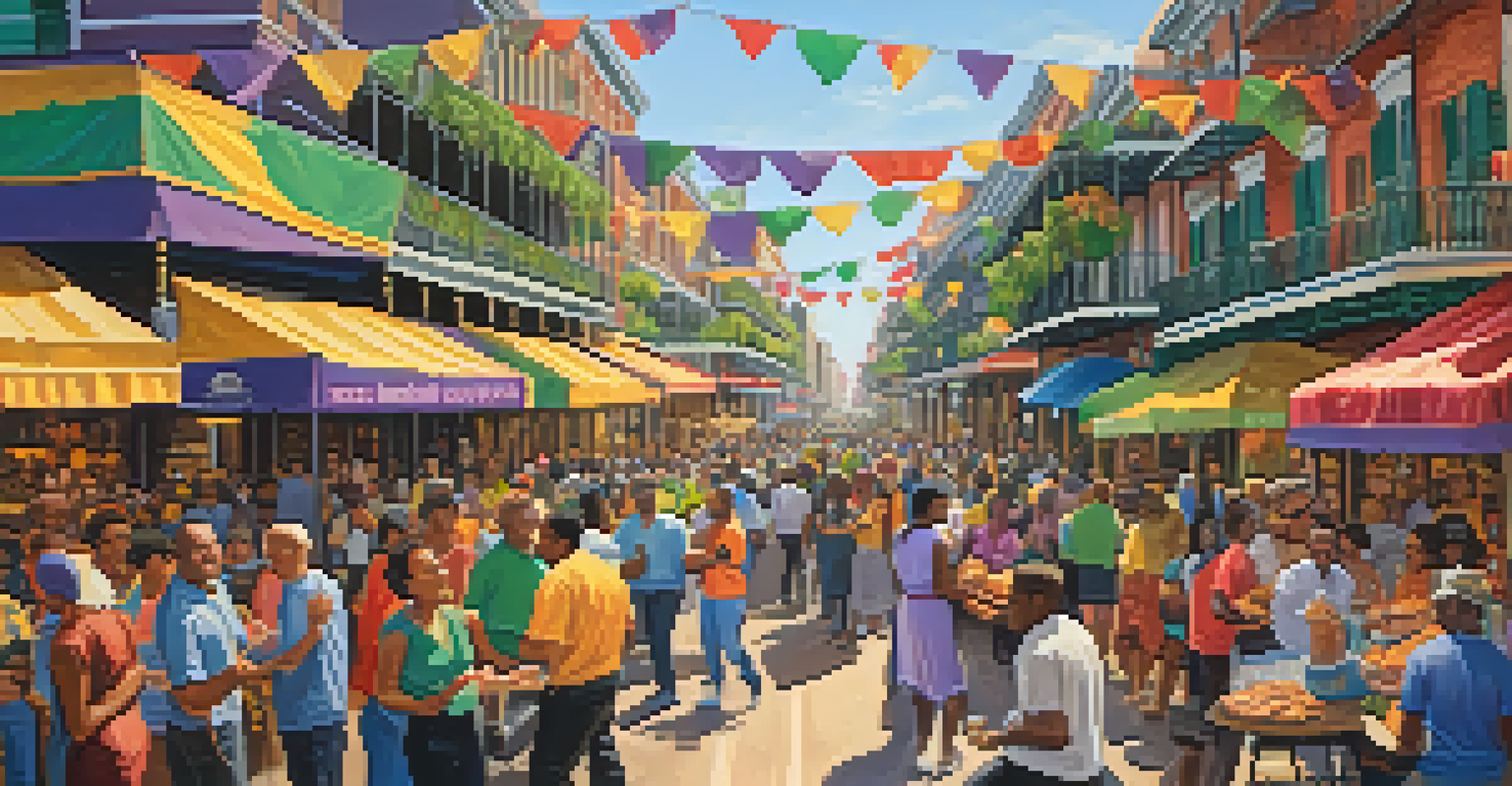Mardi Gras: The Cultural Significance of New Orleans Fest

The Historical Roots of Mardi Gras in New Orleans
Mardi Gras has a rich history that dates back to the early 18th century when French settlers brought the tradition to New Orleans. The festival, which translates to 'Fat Tuesday' in French, originally marked the last day of feasting before Lent. Over the years, it has evolved into a grand celebration, blending various cultural influences, including French, Spanish, and African traditions.
Mardi Gras is a time for the people of New Orleans to come together and celebrate their culture and community.
The first recorded Mardi Gras celebration in New Orleans occurred in 1837, featuring parades and masked balls. This early festivity established the framework for what would become a vibrant tradition. As the city grew, so did the festival, incorporating unique local customs and elaborate floats that reflect the community's spirit.
Today, Mardi Gras is not just a local event but a global phenomenon. From its historical beginnings to its present-day celebrations, it showcases the city's resilience and creativity, making it a symbol of New Orleans' cultural identity.
The Vibrant Parades: A Feast for the Senses
One of the most iconic aspects of Mardi Gras is its dazzling parades. Each parade features colorful floats, intricate costumes, and lively music that captivates spectators. The Krewe organizations, which are social clubs, play a vital role in organizing these parades and are responsible for creating the elaborate floats that parade through the streets.

As the floats roll by, crowds gather to catch 'throws'—beads, coins, and other trinkets tossed by riders. This tradition of throwing items from floats fosters a sense of community and excitement among parade-goers. The vibrant atmosphere, filled with laughter, cheers, and the sounds of brass bands, creates an unforgettable experience.
Mardi Gras' Rich Historical Roots
Originating from French settlers in the 18th century, Mardi Gras has evolved into a vibrant celebration that reflects New Orleans' diverse cultural identity.
These parades are not just entertainment; they also serve as a means of storytelling. Each float often represents a theme or local legend, offering a glimpse into the culture and history of New Orleans. This blend of art and celebration is what makes Mardi Gras a unique cultural experience.
The Role of Krewes in Mardi Gras Celebrations
Krewes are at the heart of Mardi Gras, providing organization and creativity for the festivities. These social clubs, often founded in the 19th century, are responsible for planning parades, hosting balls, and upholding traditions. Each Krewe has its own unique theme and identity, contributing to the diversity of the celebrations.
The beauty of Mardi Gras is that it invites everyone to join in, to celebrate, and to express their true selves.
Membership in a Krewe often involves a sense of camaraderie and shared purpose, as members work together to create memorable experiences for the community. Many Krewes have elaborate rituals and ceremonies, adding a layer of mystique to the festival. The secretive nature of some Krewes, particularly those that wear masks, adds to the allure of Mardi Gras.
Through their philanthropic efforts, Krewes also play a crucial role in giving back to the community. Many organizations support local charities and initiatives, ensuring that the spirit of Mardi Gras extends beyond the festivities, fostering a sense of unity and support within the city.
Cultural Influences: A Melting Pot of Traditions
Mardi Gras is a vibrant tapestry of cultural influences that reflect the diverse history of New Orleans. The festival incorporates elements from French, Spanish, African, and Creole cultures, creating a unique blend that is distinctly New Orleans. This cultural fusion is evident in the music, dance, and culinary offerings during the celebration.
For instance, jazz and zydeco music fill the air, inviting people to dance and celebrate together. The cuisine, featuring dishes like gumbo and king cake, brings flavors that tell the story of the city's diverse heritage. Each cultural element contributes to the overall experience, making Mardi Gras a true celebration of community.
Krewes Shape the Festivities
Krewes, social clubs that organize parades and events, are essential to Mardi Gras, fostering community spirit and creativity through their unique themes and traditions.
This melting pot of traditions not only enriches the festival but also fosters understanding and appreciation among different cultures. Mardi Gras serves as a reminder of the city's historical complexities and its ability to unite people from various backgrounds in celebration.
The Significance of Masks and Costumes
Masks and costumes are iconic symbols of Mardi Gras, adding an element of mystery and fun to the celebrations. Traditionally, masks were worn to conceal identities, allowing individuals to express themselves freely without societal constraints. This practice has evolved into a colorful display of creativity and artistry, with many revelers donning elaborate costumes.
The significance of masks goes beyond simple aesthetics; they symbolize the spirit of transformation and freedom. During Mardi Gras, people can step outside their everyday lives and embrace a sense of liberation. This playful aspect of the festival invites everyone to join in, regardless of age or background.
Moreover, the creativity involved in designing costumes and masks showcases local talent and craftsmanship. Many artists and designers pour their hearts into creating unique pieces that reflect personal stories or cultural themes, making each celebration a vibrant showcase of artistic expression.
The Culinary Delights of Mardi Gras
Food is an integral part of the Mardi Gras experience, offering a delicious glimpse into the culture of New Orleans. Traditional dishes such as jambalaya, gumbo, and king cake are staples during the festivities, each with its own unique history and flavor profile. These culinary delights not only satisfy the palate but also tell the story of the city's diverse heritage.
King cake, in particular, is a symbol of Mardi Gras, often decorated in the festival's colors of purple, green, and gold. The hidden plastic baby inside the cake adds an element of surprise, with the person who finds it being crowned king or queen of the celebration. This fun tradition brings families and friends together, creating lasting memories.
Culinary Delights Enhance Celebration
Food plays a vital role in Mardi Gras, with traditional dishes like jambalaya and king cake offering a taste of New Orleans' rich cultural heritage.
Food vendors line the streets during parades, offering a variety of treats that reflect the vibrant culture of New Orleans. From beignets to po'boys, the culinary offerings enhance the festive atmosphere and provide an opportunity for revelers to indulge in local flavors, making the celebration even more memorable.
The Lasting Impact of Mardi Gras on New Orleans Culture
Mardi Gras has a profound impact on the culture and economy of New Orleans. Beyond the festivities, it fosters a sense of community pride and unity among residents. The shared experiences of celebration, creativity, and tradition strengthen the bonds within the city, making it a vital part of New Orleans' identity.
The festival also attracts millions of visitors from around the world, boosting the local economy through tourism. Hotels, restaurants, and local businesses thrive during the Mardi Gras season, showcasing the city's vibrant spirit to an international audience. This influx of visitors helps preserve the cultural heritage and supports the continuation of traditions.

In essence, Mardi Gras is more than just a festival; it is a celebration of life, resilience, and community. The cultural significance of Mardi Gras extends beyond its lively parades and colorful costumes, leaving a lasting legacy that continues to shape the identity of New Orleans for generations to come.